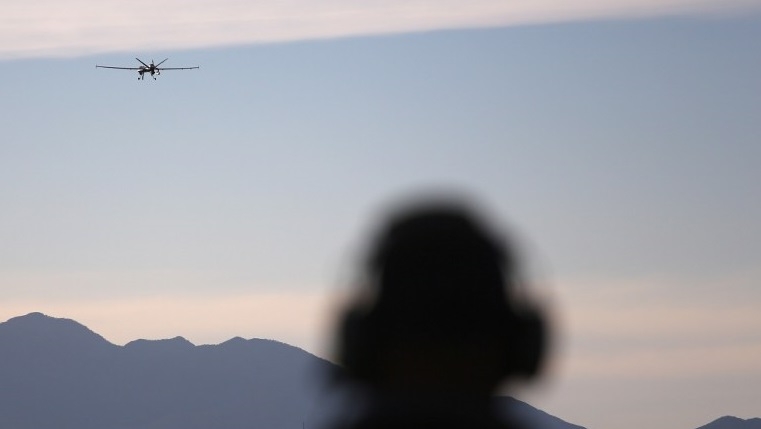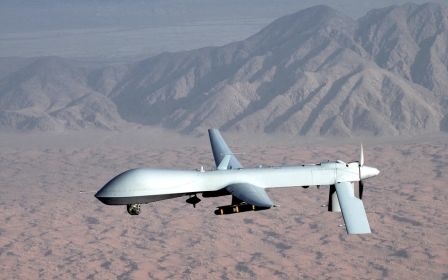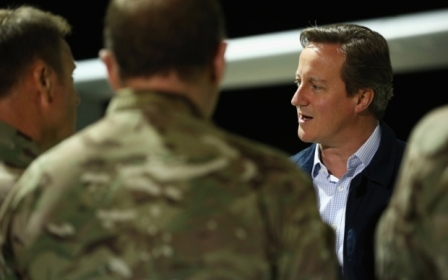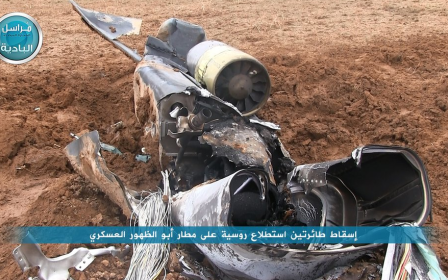
America’s secret African drone war against the Islamic State
Predators and the 'neutralisation' of 69 people in Iraq and Syria
On 7 October at an “undisclosed location” somewhere in “Southwest Asia,” men wearing different types of camouflage and dun-coloured boots gathered before a black backdrop adorned with Arabic script. They were attending a ceremony that mixed solemnity with celebration, the commemoration of a year of combat that left scores of their enemies slain. One of their leaders spoke of comradery and honour, of forging a family and continuing a legacy.
While this might sound like the description of a scene from an Islamic State (IS) video or a clip from a militia battling them, it was, in fact, a US Air Force “inactivation ceremony”. There, Lieutenant Colonel Dennis Drake handed over to Colonel John Orchard the “colours” of his drone unit as it slipped into an ethereal military limbo. But that doesn’t mean the gathering had no connection to the Islamic State.
It did.
Within days, Drake was back in the United States surprising his family at a Disney “musical spectacular”. Meanwhile, his former unit ended its most recent run having been responsible for the “neutralization of 69 enemy fighters,” according to an officer who spoke at that 7 October ceremony. Exactly whom the unit’s drones neutralised remains unclear, but an Air Force spokesman has for the first time revealed that Drake’s force, based in the Horn of Africa, spent more than a year targeting the Islamic State as part of Operation Inherent Resolve (OIR), the undeclared war on the militant group in Iraq and Syria. The Air Force has since taken steps to cover up the actions of the unit.
Base-building in the Horn of Africa
From 20 November 2014 until 7 October 2015, Drake commanded the 60th Expeditionary Reconnaissance Squadron, a unit operating under the auspices of US Air Forces Central Command (AFCENT), which flew MQ-1 Predator drones from Chabelley Airfield in the tiny sun-baked African nation of Djibouti. For the uninitiated, Chabelley is the other US outpost in that country - the site of America’s lone avowed “major military facility” in Africa, Camp Lemonnier - and a key node in an expanding archipelago of hush-hush American outposts that have spread across that continent since 9/11.
Last week, in fact, the New York Times reported on new Pentagon plans to counter the Islamic State by creating a hub-and-spoke network of bases and outposts stretching across southern Europe, the Greater Middle East, and Africa by “expanding existing bases in Djibouti and Afghanistan - and… more basic installations in countries that could include Niger and Cameroon, where the United States now carries out unarmed surveillance drone missions, or will soon.”
Weeks earlier, TomDispatch had revealed that those efforts were already well underway, drawing attention to key bases in Spain and Italy as well as 60 US military outposts, port facilities, and other sites dotting the African continent, including those in Djibouti, Niger and Cameroon. The Times cited a senior Pentagon official who noted that some colleagues are “advocating a larger string of new bases in West Africa,” a plan TomDispatch had reported on early last year. The Times didn’t mention Djibouti’s secret drone base by name, but that airfield, Drake’s home for almost a year, is now a crucial site in this expanding network of bases and was intimately involved in the war on the Islamic State a year before the Times took notice.
A few years ago, Chabelley was little more than a tarmac in the midst of a desert wasteland, an old French Foreign Legion outpost that had seemingly gone to seed. About 10 kilometers away, Camp Lemonnier, which shares a runway with the international airport in Djibouti’s capital, was handling America’s fighter aircraft and cargo planes, as well as drones carrying out secret assassination missions in Yemen and Somalia. By 2012, an average of 16 US drones and four fighter jets were taking off or landing there each day. Soon, however, local air traffic controllers in the predominantly Muslim nation became incensed about the drones being used to kill fellow Muslims. At about the same time, those robotic planes taking off from the base began crashing, although the Air Force did not find Djiboutians responsible.
In February 2013, the Pentagon asked Congress to provide funding for “minimal facilities necessary to enable temporary operations” at Chabelley. That June, as the House Armed Services Committee noted, “the Government of Djibouti mandated that operations of remotely piloted aircraft (RPA) cease from Camp Lemonnier, while allowing such operations to relocate to Chabelley Airfield.” By the fall, the US drone fleet had indeed been transferred to the more remote airstrip. “Since then, Chabelley Airfield has become more permanent. And it appears to have grown,” says Dan Gettinger, co-founder and co-director of the Centre for the Study of the Drone at Bard College and the author of a guide to identifying drone bases from satellite imagery.
Despite the supposedly temporary nature of the site, US Africa Command (AFRICOM) “directed an expansion of operations” at Chabelley and, in May 2014, the US signed a “long-term implementing arrangement” with the Djiboutian government to establish the airfield as an “enduring” base, according to documents provided to the House Appropriations Committee earlier this year by the Undersecretary of Defense (Comptroller).
The Djiboutian solution to the Islamic State
As 2014 was coming to a close, Lieutenant Colonel Dennis Drake took command of the 60th Expeditionary Reconnaissance Squadron at Chabelley. Under his watch, the unit reportedly carried out combat operations in support of three combatant commanders. AFCENT failed to respond to a request for clarification about which commands were involved, but Gettinger speculates that AFRICOM, US Central Command (CENTCOM), responsible for the Greater Middle East, and Special Operations Command were the most likely.
Before US drones moved from Camp Lemonnier to Chabelley, according to secret Pentagon documents exposed by the Intercept in October, a Special Operations task force based there conducted a drone assassination campaign in nearby Yemen and Somalia. Gettinger believes the missions continued after the move. “We know that MQ-1s have been involved in counterterrorism operations in the Horn of Africa and Predators have for many years been flying missions over Yemen,” he told me recently by phone, noting however that the strikes in Yemen have slowed of late.
“There were no US drone strikes reported in Yemen in November, the second calendar month this year without a reported attack,” researchers with the Bureau of Investigative Journalism noted earlier this month. After a lull since July, a November drone strike in Somalia killed at least five people, according to local reports. And just last week, the Pentagon announced that another US strike in Somalia had killed Abdirahman Sandhere, a senior leader of the militant group al-Shabaab.
Drake’s 60th Expeditionary Reconnaissance Squadron, however, focused its firepower on another target: the Islamic State. The unit was “a large contributor to OIR,” according to Major Tim Smith of AFCENT public affairs, and “executed combat flight operations for AFCENT in support of Operation Inherent Resolve.”
Based in Africa, it was, according to Lieutenant Colonel Kristi Beckman, director of public affairs at the Combined Air Operations Centre at al-Udeid air base in Qatar, “a geographically separated unit”. By the beginning of October 2015, drones flown out of Chabelley had already logged more than 24,000 hours of intelligence, surveillance and reconnaissance (ISR), according to the chief of operations analysis and reconstructions of the 380th Expeditionary Operations Group, its parent unit. (In an Air Force news release, that officer was identified only as “Major Kori,” evidently to obscure his identity.) According to Kori, Chabelley’s drones were also “responsible for the neutralisation of 69 enemy fighters, including five high-valued individuals.”
AFCENT failed to provide additional details about the missions, those targeted, or that euphemism, “neutralisation,” which was once a favored term of the CIA’s often muddled and sometimes murderous Phoenix Programme that targeted the civilian “infrastructure” of America’s enemies during the Vietnam War. Beckman did, however, confirm that “neutralisations” took place in Iraq and/or Syria.
The beginning of the end or the end of the beginning?
Some commentators have speculated that the transfer of the 60th Expeditionary Reconnaissance Squadron’s Predators indicates a possible end to US drone missions from Djibouti. Others suggest that the move offers a clear indication of demands for the robot aircraft elsewhere in the world.
There’s no question about the demand for drones. The Air Force pushed back plans to retire the Predator by a year - until 2018 - and began outsourcing combat air patrols to civilian contractors to deal with a paucity of drone pilots at a moment of expanding operations. Last week, it unveiled a $3 billion plan, which must be approved by Congress, to significantly expand its drone programme by doubling the number of pilots, deploying them to more bases, and adding scores of new drones to its arsenal.
All of this comes at a time when, according to a top AFRICOM commander, the Islamic State is making inroads in Africa from Nigeria to Somalia, and especially in Libya. "If Raqqa [the “capital” of its caliphate in Syria] is the nucleus, the nearest thing to the divided nucleus is probably Sirte,” said Vice Admiral Michael Franken, the command's deputy for military operations, speaking of a Libyan city in which IS fighters are deeply entrenched. “From there they look to export their terror into Europe and elsewhere.”
Dan Gettinger sees no end in sight for the use of the Djiboutian airfield or of American drones flying from there. “All the signs point to a more permanent installation at Chabelley,” he says, noting a string of construction contracts awarded for the base in recent years. Indeed, at the end of October, Navy Seabees were constructing another aircraft maintenance pad there. This month, they are working to extend the apron - where aircraft can be parked and serviced - at the drone base. It’s the Predator that’s on its way out, he tells me. “I think the MQ-1 is becoming old hat at this point.”
Like Gettinger, Jack Serle of the Bureau of Investigative Journalism sees the larger, more heavily armed cousins of the Predator, MQ-9 Reapers, as the future of drone operations at the satellite Djiboutian base. “I don't think this means the Predators the 60th launched and recovered are being retired - I think they'll have been redeployed,” he told me by email. “And I don't think this means Chabelley is denuded of drones. I think it means Reapers only will be operating out of there.”
“The personnel that were assigned to the 60th were sent back to the States to retrain on other weapon systems and the assets were redistributed to the States, [European Command], and CENTCOM,” AFCENT’s Major Tim Smith told me. “And this unit has not been replaced with another.” Military press materials suggest, however, that members of the 870th Air Expeditionary Squadron and the 33rd Expeditionary Special Operations Squadron have recently been operating at Chabelley airfield. The latter unit has been known to fly Reapers from there.
Family planning
US Air Forces Central Command failed to provide additional information in response to multiple requests for clarification about missions carried out by the 60th Expeditionary Reconnaissance Squadron. “Due to force protection concerns and operational security, I cannot discuss further,” Smith explained, although how the security of an inactive unit could be compromised was unclear. Smith also referred me to AFRICOM for answers. That command, however, failed to respond to repeated questions about drone operations flown from Chabelley.
During the course of my reporting, the Air Force news release about the 7 October inactivation ceremony was removed from the AFCENT website, leaving only an error message - "404 - Page not found!" - where an article with minimalist details about the “neutralisation” of “enemy fighters” by drones once stood. AFCENT failed to reply to a request for further information on the reason the story was withdrawn.
Nor did the command respond to a request for an interview with Lieutenant Colonel Dennis Drake. Before he travelled home to surprise his own family, however, Drake spoke of the “family” he had forged as, in the words of Major Kori, he “engaged enemies of the United States from Chabelley Airfield”.
“My desire at the beginning was simple: make the squadron a family while still continuing the tradition of excellence the previous commanders already established,” said Drake. “[I]f I took care of the people they took care of the mission... I am most proud of the family this squadron became.”
Today, those words, along with photos of the ceremony, have vanished from AFCENT’s website, joining a raft of information about America’s war against the Islamic State, operations in Africa, and drone campaigns that the military has no interest in sharing with the taxpayers who foot the bill for all of it and in whose name it’s carried out. For more than a year, US drones flying out of Djibouti waged a secret war against the Islamic State. For more than a year, it went unreported on the nightly news, in the country’s flagship newspapers, or evidently anywhere else.
The New York Times now reports that "the Pentagon has proposed a new plan to the White House to build up a string of military bases in Africa" and beyond, "bring[ing] an ad hoc series of existing bases into one coherent system that would be able to confront regional threats from the Islamic State, Al-Qaeda, or other terrorist groups."
But the expansion of Chabelley, the far-flung network of bases of which it’s a part, and the war on the Islamic State waged from it suggest that there is little "new" about the proposal. The facts on the ground indicate that the Pentagon’s plan has been underway for a long time. What’s new is its emergence from the shadows.
- Nick Turse is the managing editor of TomDispatch.com, where this article first appeared and a fellow at the Nation Institute. A 2014 Izzy Award and American Book Award winner for his book Kill Anything That Moves, his pieces have appeared in the New York Times, the Intercept, the Los Angeles Times, the Nation, and regularly at TomDispatch. His latest book is Tomorrow's Battlefield: US Proxy Wars and Secret Ops in Africa. Copyright 2015 Nick Turse.
The views expressed in this article belong to the author and do not necessarily reflect the editorial policy of Middle East Eye.
Photo: A Predator drone operated by US Office of Air and Marine (OAM), takes off for a surveillance flight near the Mexican border on March 7, 2013 from Fort Huachuca in Sierra Vista, Arizona (AFP).
New MEE newsletter: Jerusalem Dispatch
Sign up to get the latest insights and analysis on Israel-Palestine, alongside Turkey Unpacked and other MEE newsletters
Middle East Eye delivers independent and unrivalled coverage and analysis of the Middle East, North Africa and beyond. To learn more about republishing this content and the associated fees, please fill out this form. More about MEE can be found here.







